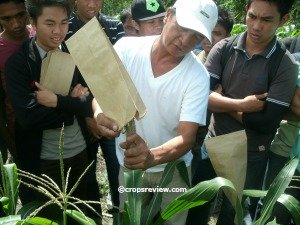What is agronomy?
This is another question that is as important as “what is horticulture?” in relation to the study and practice of plant agriculture.
For those who desire to specialize in either agronomy or horticulture, the two main divisions of crop production, it is important to be able to distinguish between the two, or at least learn when both terms may apply to the same crop, or when an outright answer has to be deferred.
It will be embarrassing to find oneself stammering when suddenly asked to explain what is agronomy or required to give its definition (or horticulture, or agriculture).
Familiarity with the terms and their scope will also simplify literature research.
For example, anyone who wishes to find information on cereal crops can likely find the same from books on agronomy rather than on horticulture.

What is Agronomy vs. Horticulture: Distinctions Not Well Settled
It should be realized from the outset that the distinction between agronomy and horticulture is not well established.
Both terms can also apply to the same crop.
This is so with grain or forage corn (agronomic) and sweet or young corn (horticultural) as well as pineapple grown for fiber (agronomic) and those grown for fruit (horticultural).
Further, primary usage is not the only basis of distinction.
Certain global development may cause a significant change that will affect the traditional uses of certain crops.
For example, an increase in the world market demand for coconut water from young nuts may drastically affect the production of mature nuts for copra.
If this happens very significantly, the established classification of coconut as an agronomic crop may alter.
In addition, other criteria of classification such as the intensity of care and value of the product are also considered, and these may vary with time and place.
In the Philippines, sweet potato and white potato, as well as field beans, are considered horticultural crops based on their intensive management.
However, they are classified as agronomic crops in countries where they are grown through mechanized systems on an extensive scale, according to Lantican (2002).
According to Janick (2002), the present divisions of agriculture into agronomy and horticulture, as well as forestry, originated with medieval agriculture in Europe.
A system of differentiation was used based on crops and the intensity of production.
It is agronomy if the production system is in open fields or meadows are utilized to produce grains and fodder for animals.
Horticulture was involved with the production of tree fruits and vines, vegetables, ornamental plants, herbs, and medicinal plants in kitchen gardens.
But, as the distinguished author put it, this system breaks down in the tropics where it is never clear where agronomy ends and horticulture begins.
Definition of Agronomy: Is Reference to Field Crops Exacting?
The term agronomy is derived from the two Greek words agros, meaning field, and nomos, meaning to manage.
Thus agronomy has been defined in short concise terms as the art and science of field crop production and management.
But this definition does not provide a clear demarcation line with the general application as to what is agronomy versus horticulture and their scopes.
The term “field” or “open field” refers to a large or extensive area of production in agronomy while “garden” refers to a small area in horticulture.
These terms are not exacting anymore to be used as a basis for distinguishing the two divisions of agriculture.
The extensiveness of production varies from country to country or even from place to place within the same country depending on many factors such as climate and physical features, availability of capital, and market movement.
As of 2009 in the Philippines, pineapple for fruit (a horticultural crop) was grown in 21,864 ha and 19,300 ha in South Cotabato and Bukidnon, respectively, surpassing the hectarage for the agronomic crop abaca or Manila hemp (549 ha and 3,090 ha, respectively) in the same areas (BAS 2010).
To rephrase it, the pineapple was grown in South Cotabato as a horticultural crop, that is, for fruit production on 21,864 hectares of land.
In comparison, abaca, an agronomic crop intended for fiber production, was grown in an aggregate area of 549 hectares in the same province.
This means that the crop area for pineapple exceeded that of abaca by a wide margin (21,864 ha vs. 549 ha).
The growing of pineapple in a larger area in South Cotabato similarly occurred in the province of Bukidnon.
The above data, therefore, negate the presumption that the growing of agronomic crops is more extensive than horticultural crops.
This reveals also the ambiguity in the meaning of field crop as that which is grown extensively or on a large scale, or in a wide area of land.
Consequently, the common definition of agronomy with reference to “field crops” should be revisited.
An exacting definition with the international application, if possible, ought to be formulated.
In the meantime, it would be safer to clarify what is agronomy vs. horticulture based on the different groupings of crops and the specializations under their domains as well as their general features.
These coverages are fairly well established. Click here to read.
